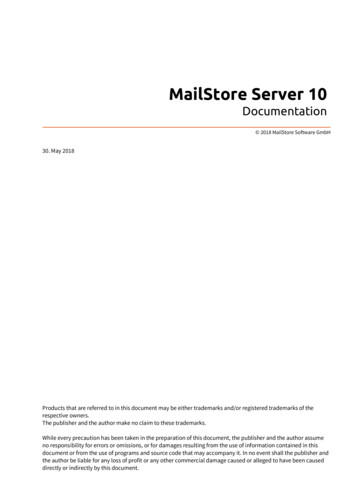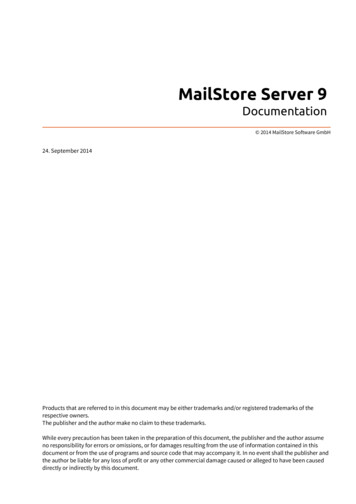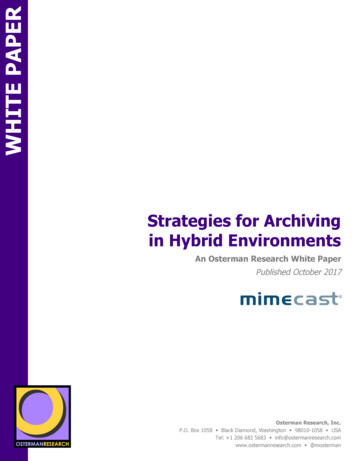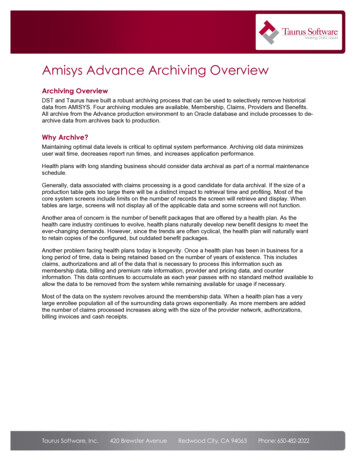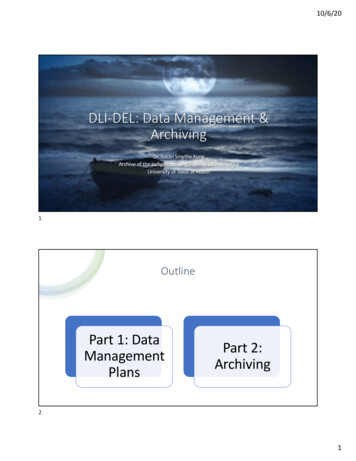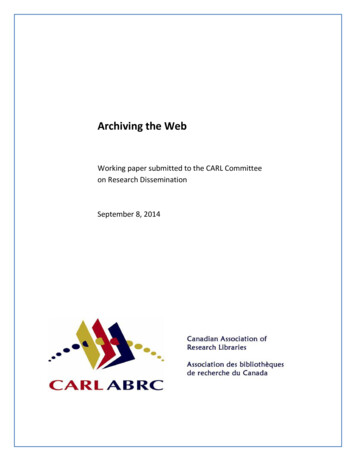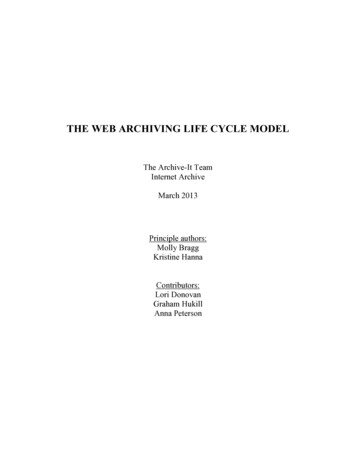
Transcription
THE WEB ARCHIVING LIFE CYCLE MODELThe Archive-It TeamInternet ArchiveMarch 2013Principle authors:Molly BraggKristine HannaContributors:Lori DonovanGraham HukillAnna Peterson
Introduction1IntroductionThe technological tools for archiving the web have been evolving steadily for more than adecade. However, best practices and a common model of web archiving have yet to emerge.The Web Archiving Life Cycle Model is an attempt to incorporate the technological andprogrammatic arms of web archiving into a framework that will be relevant to any organizationseeking to archive the web. Archive-It, the leading web archiving service in the community,developed this model based on its work with memory institutions around the world.The Internet Archive has been archiving the web since 1996. In 2002, the InternetArchive released Heritrix, the open source web crawler, which is the software tool that capturescontent from the World Wide Web. In 2009, the Heritrix crawler’s file output, the WARC file,was adopted as an ISO standard for web archiving, demonstrating both the prevalence of activeweb archiving programs and the importance of the web crawler itself. In early 2006, the InternetArchive launched the Archive-It web archiving service (www.archive-it.org) with thirteen pilotpartner institutions. Archive-It is a subscription web archiving service that helps partnerorganizations harvest, build, and manage born digital collections. The partner base has steadilyexpanded since its launch, with 238 partners in forty-six U.S. States and fifteen countries, as ofJanuary 2013.Despite growth in the number of web archiving programs, many institutions still strugglewith developing best practices and methodologies to accomplish their goals. This difficultypartially stems from constantly evolving web technology, which can make it difficult to archivecertain types of content effectively. Conflicting and evolving policy decisions from variousstakeholders, as well as shifting organizational structures and job responsibilities, pose furtherobstacles to establishing best practices. Additionally, some organization stakeholders have notfully adopted the belief that web archiving is crucial to their digital preservation activities; as aresult, funding remains limited or non-existent.In order to address the lack of best practices and to increase awareness of the importanceof web archiving as fundamental to digital preservation, the Archive-It team developed the WebArchiving Life Cycle Model (WALCM). This model is based on the team’s experiences as wellas lessons learned from countless partner institutions, including in-depth case studies of six ofthose institutions. The WALCM is an attempt to represent common workflows and create a
Introduction2measurable model for organizations to reference in order to create or improve their webarchiving programs.Developing the Web Archiving Life Cycle ModelThe Archive-It team developed the model organically, using feedback and lessonslearned from their partnerships with organizations archiving the web. These partner institutionsprovide feedback based on their use of the service, and communicate with the Archive-It teamthrough email, phone calls, and in-person conversations at conferences and partner meetings.Additionally, more formal feedback comes through partner presentations at conferences, surveysdesigned by Archive-It staff, as well as formal or informal literature partners create relating howthey and their colleagues meet the challenges of web archiving.The Archive-It team drafted the first iteration of the Web Archiving Life Cycle Model,which was circulated to a subset of Archive-It partners who provided feedback on missing orsuperfluous elements and on the model’s visual presentation. Next, the Archive-It teamincorporated this input into a more visually appealing model that was sent to all Archive-Itpartners for general feedback. This feedback inspired a further re-design that more accuratelyreflected partners’ experiences with web archiving, and eventually, the resulting version of themodel discussed in this paper. The information in this paper is also based on in-depth emailexchanges and phone interviews that took place between April and July 2012 with six Archive-Itpartners: Columbia University, University of Alberta, Montana State Library, State Library ofNorth Carolina, North Carolina State Archives and Creighton University. Information in thispaper also comes from a survey of Archive-It partners conducted in August 2012.The Model ExplainedThe model is an attempt to distill the different steps and phases an institution experiencesas they develop and manage their web archiving program. Although the model is broken downinto individual steps, each action is not discrete. The steps and phases are related, with asignificant amount of overlap between them.The shape of the model is circular to suggest the repetitive nature of the steps in the lifecycle (see Figure 1). As users move through each step, they eventually find themselves back atthe beginning, or repeating certain steps, depending on their tasks. For example, the process can
TheModelExplained3restart when an institution adds a new website to an existing collection, creates an entirely newcollection, or reviews archived content and modifies crawl settings or scope. The modelincludes circles within circles to suggest these repetitive cycles within the bigger process.Figure1WebArchivingLifeCycleModelThe outermost level of the life cycle is the policy band. Almost every aspect of webarchiving involves some sort of policy decision. These policy decisions may involve developinga new policy specific to web archiving or the adaptation of an existing policy to new collectingactivities. By encompassing the life cycle steps with a policy band, the model visually representsthe ever-present nature of policy making. In a second band, the model similarly representsmetadata and description. Archive-It chose to incorporate metadata as a band rather than as asegment of the wheel to emphasize that creating, importing, and exporting metadata is anongoing process that occurs in tandem with a number of other activities in the life cycle.
TheModelExplained4The blue circle just inside the policy band represents the high-level decisions aninstitution faces as it sets up and manages its web archiving program. The individual steps arebriefly defined as follows and will be discussed in more depth later in this paper. Vision and Objectives: institutions clarify the goals of their web archivingprogram. Resources and Workflow: institutions review their available resources includingfinances, expertise, staff, potential collaborators and others in order to determinehow to proceed with developing or changing their web archiving program. Access / Use / Reuse: institutions make decisions about whether and how toprovide access to their collections and monitor how patrons use the content. Preservation: institutions make decisions about how they want to preserve thedata they collect in their web archiving activities. This includes both data files andmetadata. Risk Management: institutions consider their approach to risk in creating a webarchiving program, they look at copyright and permissions as well as access.The inner orange circle describes the day-to-day tasks involved in the business ofarchiving the web. These tasks include the following: Appraisal and Selection: institutions decide specifically which websites they wantto collect. Scoping: institutions may opt to archive portions of a website, whole sites, oreven entire web domains. Data Capture: institutions fine-tune how they want to capture their data throughdecisions about crawl (capture) frequency and types of files to archive or notarchive. The scoping and data capture phases of the life cycle often overlap asthey involve similar activities and decisions. Storage and Organization: This step includes a temporary or long-term storageplan for the archived data. For some institutions, the storage and organizationphase of the life cycle might also constitute their preservation activities.
TheModelExplained 5Quality Assurance and Analysis: institutions review what they have archived andhow well the resulting collection satisfies the goals they set at the beginning of thelife cycle.At the center of the life cycle is the collection itself, the archived web content. This datais the end result of all preceding steps, and it is what will be preserved. Capturing and preservingcollections of data is at the heart of all web archiving activities and is therefore the center of themodel.Web Archiving Life Cycle Model: The Outer CircleThe Outer Circle: Vision and esTo determine a vision and objective for web archiving (see Figure 2), an institution mustask itself why it is choosing to archive the web, what it wants to accomplish in doing so, andhow these steps relate to the institution’s broader mission. This step in the cycle primarily occursas institutions initially plan their program; however, institutions do tend to revisit and redefinetheir web archiving objectives throughout the life of the program. These periods ofreexamination may result from a specific stimulus, such as a change of resources, or may be anongoing question considered along with and in relation to their other collection policies.Memory institutions choose to archive the web for many different reasons depending ontheir own institutional mandates as well as the objectives of their stakeholders. Some institutions
TheOuterCircle:VisionsandObjectives6choose to archive the web because they believe that specific web content is at risk ofdisappearing and therefore needs to be captured and kept accessible--particularly in the case ofrapidly changing spontaneous events, like natural or manmade disasters, political uprisings, andmemorials for public figures. Other institutions have mandates to archive specific publicationsthat are only available in digital formats, such as university course catalogs and state or localagency reports and publications. Additionally, some institutions have legal mandates to archiveall official records produced by the institution within their domain, constructing an historicalrecord of their institution’s web presence over time. Still other institutions view web archivingas an extension of their overarching collection development policy or their digital preservationprograms, and they may archive web content that enhances or supplements the topics alreadyemphasized in their traditional collecting activities. Researchers and academics are alsorecognizing the increasing influence of social media sites, and the importance of creating athematic/topical web archive on a specific subject or topic that includes different perspectivesand social commentary only available in tweets, blogs, posts and comments. Additionally, stateand local archives need to capture the social media profiles and activities of their elected officialsand agencies. Many institutions have diverse goals and as a result set up multiple collections toachieve each objective. Regardless of the specific vision for each web archiving program, thevision shapes many of the policies and decisions made in later steps of the web archiving lifecycle.As one example, Columbia University Library has been working with Archive-It since2008. The library collects web content in several areas. First, the library captures the ColumbiaUniversity web domain in coordination with University Archives. Second, the library hasseveral other collections built around specific themes and topics: global human rights, historicpreservation and city planning, and New York City religious institutions. These born-digitalcollections complement and supplement the library’s existing physical collecting activities.Columbia describes its overarching goal in web archiving as “believ[ing] that freely availableweb content [is] an increasingly important source of content necessary for current and futureresearch that [is] not yet integrated into academic library collection development models”(Thurman and Fallon 2012).Similar to Columbia University, University of Alberta also realized that the universitywas not capturing born digital material and that it needed to include web archiving in its vision
TheOuterCircle:VisionsandObjectives7for its digital preservation strategy. However, the university did not start out with such a clearvision. Originally, the University of Alberta inherited over eighty websites from a non-profitorganization that lost its funding. Realizing that hosting these websites would be resourceintensive, the university took an “archiving” approach, which they felt would be a moresustainable way to take custody of the content. University of Alberta thus began using theArchive-It application to complete this project. Their first year with Archive-It (2009) waslargely focused on the websites inherited from the dissolved non-profit organization (Harder2012).Starting in 2010, the University of Alberta began using Archive-It as a broader collectiondevelopment tool. The development of national web archiving programs is not as strong inCanada as it is in some other countries. To help fill this gap, the university library has beguncollecting in earnest in several areas, including: Canadian prairie politics and economics,government documents, grey literature for business and health sciences, circumpolar studies, andprovincial education curriculum materials. In this way, the vision of their Archive-It programmatches their collection development policy for their non-digital collections. Two of their bigissues moving forward relate to refining their discovery strategy and improving the visibility oftheir collections. They are particularly interested in out how to most effectively provide access totheir web archives alongside other digital collections. Because the university is concerned withdigital scholarship, they want to make sure researchers are able to use their web archivecollections just as they now use other resources (Harder 2012).Montana State Library (MSL) offers an example of a different institutional vision. TheMSL web archive seeks to archive state documents, which are now often only available online.Their objective is to “meet the information needs of state agency employees, provide permanentpublic access to state publications, support Montana libraries in delivering quality library contentand services, work to strengthen Montana public libraries, and provide visually or physicallyhandicapped Montanans access to library resources” (Downs, Kammerer and Stockwell 2012).A Montana State Library staff member summarizes the library’s reasons for archiving the web:“With the precipitous decline in the submission rate for print publications and an inverse,exponential rise in the rate of web based publishing, Archive-It has completely supplanted thehistoric state depository library tradition of acquiring and distributing print state publications oneat a time” (Downs, Kammerer and Stockwell 2012). At the beginning of their subscription in
TheOuterCircle:VisionsandObjectives82007, Montana State Library set up one policy to govern most aspects of their web archivingprogram, including selection criteria for what to archive, crawl frequency, and outreach.Interactions between Archive-It and MSL since 2007 indicate that this approach has beensuccessful and is meeting the objectives of the state library.The Outer Circle: Resources and wThe resources and workflow phase of the life cycle can be interpreted in several ways. Inthe context of the WALCM’s outer circle, institutions examine the resources and workflows thatcan be leveraged to create or maintain an entire institution’s web archiving program (see Figure3). In this way, resources and workflow can be considered similarly to “policy”, as they can beapplied in multiple areas of the web archiving life cycle model. Resources and workflow shouldalso be considered as general program management terms that can be applied to each of theelements in the model’s inner ring. In this context, resources and workflow become part of theday-to-day activities of web archiving. For example, how much time can an institution spendreviewing their crawls or how many people should add websites to the Archive-It application?Subsequent sections of this paper will discuss specific management workflows in depth.One of the key resources organizations have at their disposal is their staff. In-depthdiscussions with several Archive-It partners in the spring and summer of 2012, as well as asurvey of fellow Archive-It partners, conducted by Marquette University, reveal some
TheOuterCircle:ResourcesandWorkflow9comprehensive data regarding the staffing models in place at a wide range of Archive-It partnerinstitutions. Of the thirty-seven institutions that responded to the Marquette University survey,one-third have two or more individuals involved with Archive-It, and over 25% have four ormore individuals involved. The survey also found that half of the responding institutions spendless than one hour per week working with their Archive-It accounts, and 44% spend 1-5 hoursper week working with the application. The Marquette survey also asked respondents todescribe the types of individuals working within Archive-It. Table 1 displays these findings;please note that respondents could select more than one staff grouping, so results do not sum to100% (Sweetser Archive- ItArchives Staff64%Library Staff42%Digital Projects Staff30%Information Technology Staff8%Other (such as students or “web team”)8%Source:(Sweetser2011)Discussions with the six Archive-It partners highlighted in this paper revealed similarresults to the Marquette survey. The partners provided details about their Archive-It staffing,including the number of staff and nature of their work. The results are summarized in Table 2.These results share another similarity with the Marquette University survey results: most of thestaff tend to come from the library or archives (the Archive-It team is inferring that subjectspecialists and metadata curators are part of a library staff), with additional involvement frominformation technology staff and students.
andtypeofstaffworkingwithArchive- ItInstitutionNumber of StaffStaffing DetailsInvolvedColumbia University1 some involvementCurrently (2012) one web curator runs crawls,from other staffscopes seeds and manages the Archive-Itaccount, although they have had two webcurators in the past. Students, the metadatacurators, and web programmers also usedifferent parts of the application on a morelimited basis.Creighton University 1Creighton University has one full-timearchivist, and one of his responsibilities is toadminister Archive-It; he also gets a smallamount of help from others at the Library.University of1 lead technical person,University of Alberta has a very large networkAlbertawith up to 40 peopleof individuals actively using Archive-It, manyactively logging into theof whom are subject specialists.applicationMontana State3LibraryThe most active users are the state publicationslibrarian (who oversees the program), themetadata cataloger, and the library systemsprogrammer/analyst who handles technicalissues.State Library of4Management of Archive-It is evenly split withNorth Carolina andtwo representatives from the state library andNorth Carolina Statethe state archives.ArchivesIn addition to staffing, the resources and workflow in this model also encompass howinstitutions manage other resources. For example, Columbia University uses an internal databaseto track any information that cannot be included in the Archive-It application, such as
e information and permissions data from sites they have contacted. Anotherexample is the decision to collaborate and divide management of the web archiving programbetween the State Library of North Carolina and the North Carolina State Archives. The twoinstitutions manage a single collection of state government agency websites. In dividing up theday-to-day work, the two agencies have several well-established workflows, which they havedeveloped since they first began using Archive-It in 2005. The state library and archivesalternate responsibility for conducting the crawls, and both institutions perform quality control ofthe data harvested. The individual staff members have turned over throughout the years;however, despite this turnover, the institutions have found that their partnership has been an“easy collaboration to maintain” (Eubank, et al. 2012).Of the six Archive-It institutions highlighted in this paper, the University of Alberta hasthe largest web archiving program in terms of staffing. The University of Alberta began usingArchive-It with a small team of several individuals in 2009, and the team has since grown to overtwenty-two people actively contributing to the program. They have also incorporated a numberof subject specialists into their work. Additionally, the team has a government documentslibrarian and a metadata librarian involved in the application. A representative from informationtechnology supports these individuals and filters their questions to Archive-It staff at InternetArchive. At a higher level, the library has a “born digital working group” composed of stafffrom around the library. This group, composed mostly of individuals from collectiondevelopment, helps shape web archiving policy in general and use of Archive-It in particular.Additionally, an Archive-It users group, which has a broad membership base, builds and sharesknowledge about Archive-It.Unlike the University of Alberta, Creighton University only has one archivist whomanages the university’s Archive-It subscription and also initially championed it as a necessaryresource. David Crawford learned about Archive-It at the 2008 Society of American Archivistsconference and worked to build support for setting up an Archive-It subscription at Creighton.Eventually, he received a donation from a board member to initiate their web archiving programby funding a subscription to Archive-It. Using a tool like Archive-It allows Crawford toaccomplish his goal of archiving the university’s web presence, which he would not have beenable to do on his own due to a lack of in-house expertise (Crawford 2012). Crawford’sexperience of having to build support for web archiving on his own seems consistent with
TheOuterCircle:ResourcesandWorkflow12interactions Internet Archive has had with other small institutions like Creighton University.Smaller institutions often take longer to get their program up and running due to fewer staffingand fiscal resources. Some smaller colleges and universities have formed consortiums to supporttheir web archiving programs in order to expand their pool of resources for web archiving (seefor example the Tri-College Consortium of Bryn Mawr, Swarthmore and 74, one of the original Archive-It pilot partners).The Outer Circle: ReuseEstablishing access, use, and reuse policies is vital to a successful web archiving program(see Figure 4). Institutions consider whether and how they want to provide open access to theirweb archives, if and how to promote the collections, as well as how to govern public use of thematerial. Managing these processes is the primary goal of the access/use/reuse phase of the webarchiving life cycle.Part of the creation of an access policy will include choosing the specific technology ortool to provide access to the archived webpages. However, for the purposes of this model, theArchive-It team instead considers the higher-level policy decisions around access. This is in partdue to the fact that all of the individuals interviewed for this project access web archives usingWayback software, the open-source viewing tool that allows the public to browse archivedwebpages just as they would experience a live webpage.
TheOuterCircle:Access/Use/Reuse13The majority of Archive-It partners have their archived content publicly available,although an increasing number are requiring some content to be kept restricted for a period oftime—either a specific URL or domain, an individual collection, or their entire account withmultiple collections. And the Archive-It team is starting to see more requests for content to berestricted by IP address to enable reading rooms in university libraries to have more flexibilityaround access. (Note: the service expects to have this capability in April 2013).Archive-It partners can refer their patrons to the Archive-It website (http://www.archiveit.org) for collection access or they can link to their collections from their own site through asearch box or links to the Wayback software. Both approaches work for partners depending ontheir access needs. A fair number of Archive-It partners create separate landing pages for theircollections with their organization's look and feel. For example, the State Library of NorthCarolina and the North Carolina State Archives provide access to their Archive-It collectionsfrom their own website. They have created a robust portal, which provides information aboutweb archives for the public and information professionals, as well as instructions for using theweb archives (http://webarchives.ncdcr.gov/) (see Figures 5 and 6). Additional examples ofArchive-It partner landing pages can be found online rtners%27 Web Pages for ArchiveIt Collections. Creighton University, on the other hand, has taken a different approach. Theyrefer their patrons to the Archive-It website for access to the collections and do not provideaccess from their institutional website. In David Crawford’s words, they prefer their patrons tobe “self directed” (Crawford 2012).
ives.ncdcr.gov/
es.ncdcr.gov/about.htmlLike the State Library of North Carolina and the North Carolina State Archives,Montana’s State Library also created a portal on their own website that provides access to theirArchive-It collections (http://msl.mt.gov/For State Employees/connect/default.asp).1 Inaddition to providing access to data collected using the Archive-It service, Montana State Libraryextracted older webpages dating back to 1996 from the Internet Archive’s general web archive.These webpages are accessible from the portal along with their Archive-It data, which dates backto 2006. The library’s goal for providing access through their own website is to “create a singleidentifiable brand that will be associated with state government information” (Downs, Kammererand Stockwell 2012). Montana State Library has also found other innovative ways to drawattention to their web archives. All Montana State Library webpages contain a “page history”link in the footer. These links direct visitors to archived versions of the webpage so they can seehow it has changed over time. For example, the “page history” on the state library’s homewebpage http://msl.mt.gov/ 2 directs the visitor to a list of easy to browse capture dates for eLibrary’sURLsmaychangeinthenearfuture.
TheOuterCircle:Access/Use/Reuse16webpage: http://wayback.archiveit.org/499/query?type urlquery&url http://msl.mt.gov/&dates (see Figures 7 and footer
TheOuterCircle:Preservation17The Outer Circle: a gathered in preparation for this paper suggests that preservation is an evolving issuefor institutions that archive the web, which goes hand in hand with the evolving nature of digitalpreservation and the development of digital repositories (see Figure 9). The Archive-It teamfound that their partners tend to employ several different preservation strategies. Manyinstitutions that work with the Archive-It service rely on the Internet Archive for storage andpreservation of their WARC files and associated metadata. There are several partners that alsoreceive a copy of their data on a hard drive or download their WARC files directly from InternetArchive servers. A few partner institutions are working to incorporate WARC files into theirlocal digital repository, although these projects are still in their infancy. The Internet Archivefollows best practices for preservation with redundancy, transparency and data integrity checks.And the Archive-It service works with several preservation systems to facilitate other criteria tomeet our partners’ needs.Based on a recent survey completed by Archive-It partners, partners do want to preservetheir data and have multiple copies of their data in multiple locations. However, they aregrappling with how to get there. In the survey, 56% of respondents answered that they wouldlike to store their data in their own local repository (regardless of the platform they use).However, 31% of partners reported that they prefer to store their data at the Internet Archive,either because they are satisfied with that strategy or do not have the means to preserve the data
TheOuterCircle:Preservation18elsewhere. Approximately 60% of respondents do not yet have a local digital repository. Thetwo highest cited reasons for not having a repository are “unsure of our needs” and “weighingwhich system to choose” (Hanna 2012). These results along with anecdotal informatio
At the center of the life cycle is the collection itself, the archived web content. This data is the end result of all preceding steps, and it is what will be preserved. Capturing and preserving collections of data is at the heart of all web archiving activities and is therefore the center of the model. Web Archiving Life Cycle Model: The Outer .


